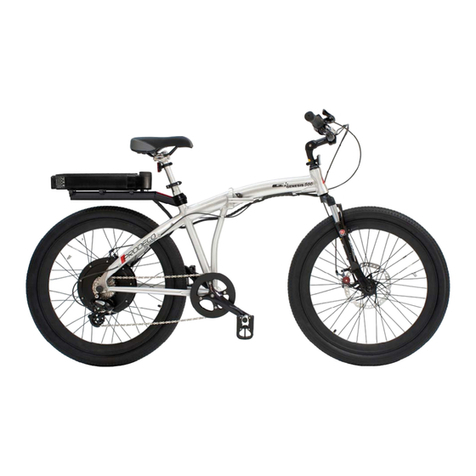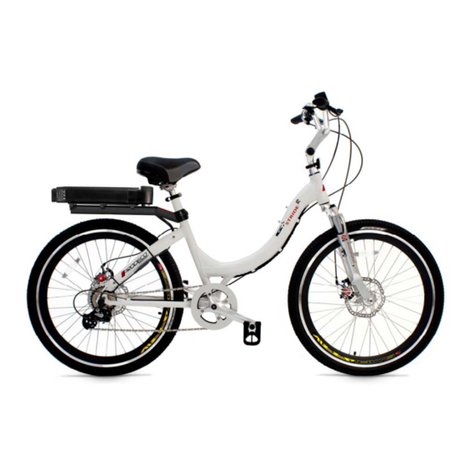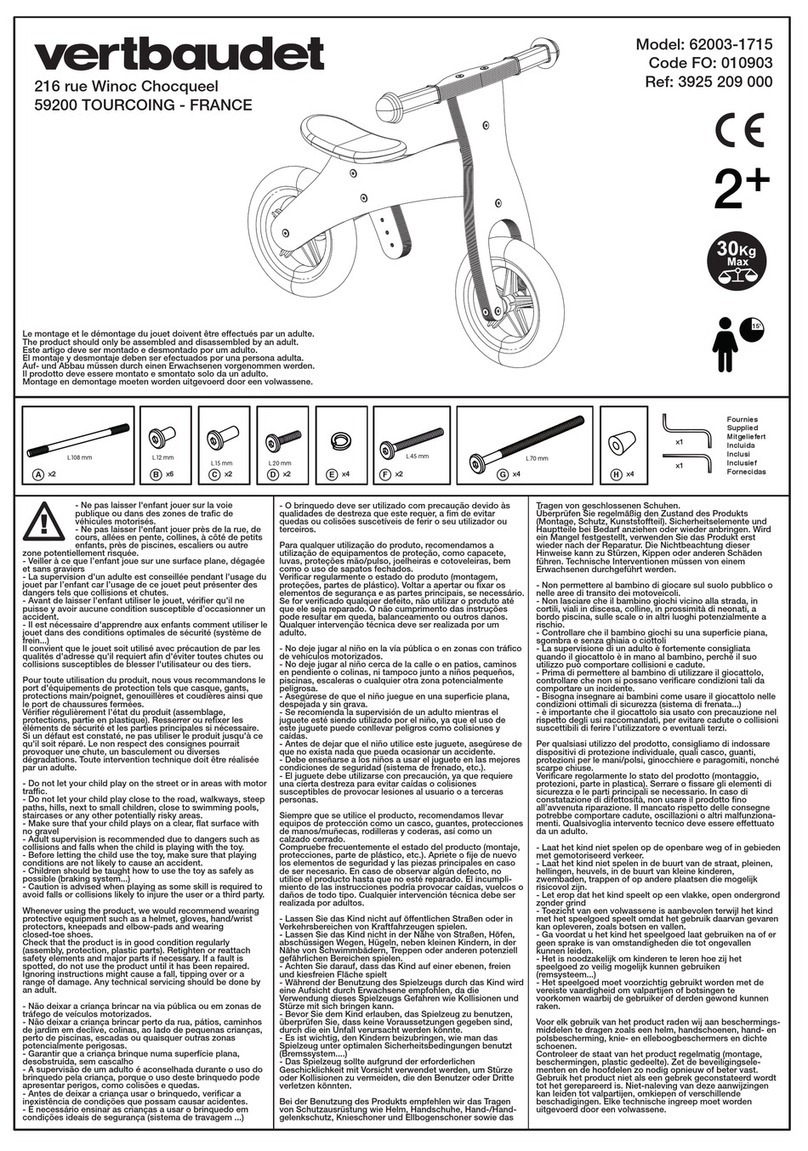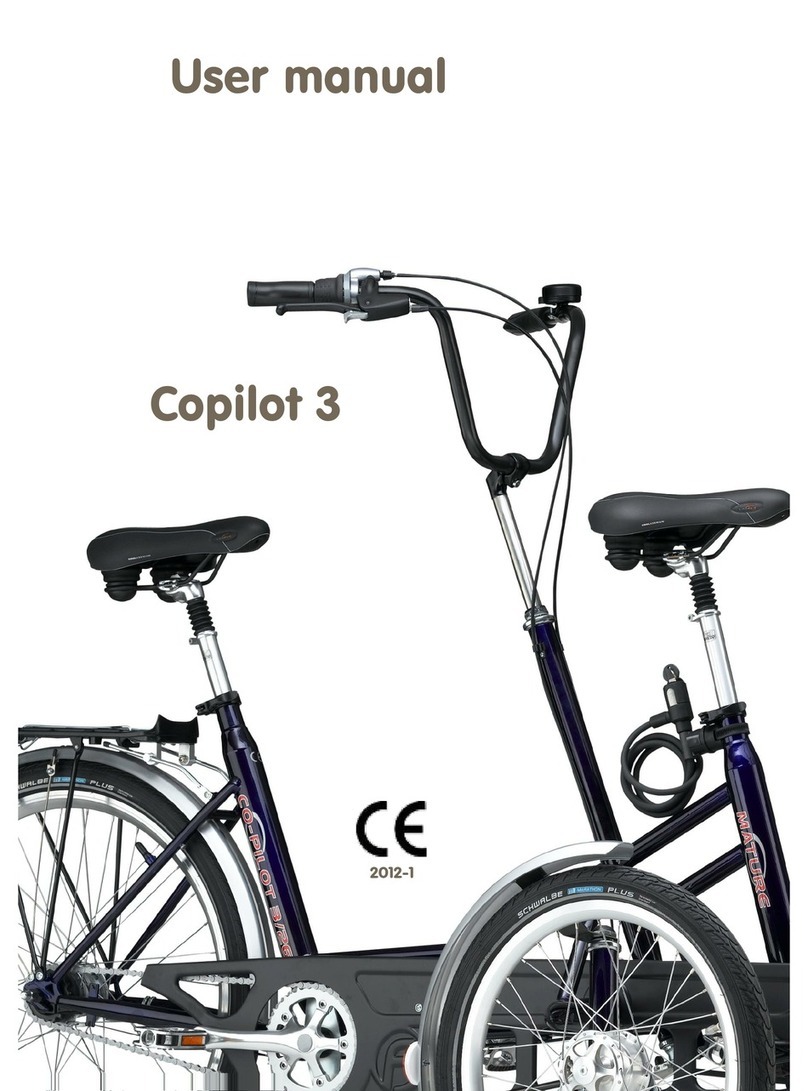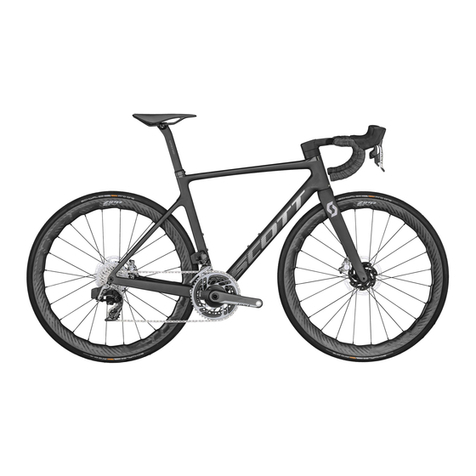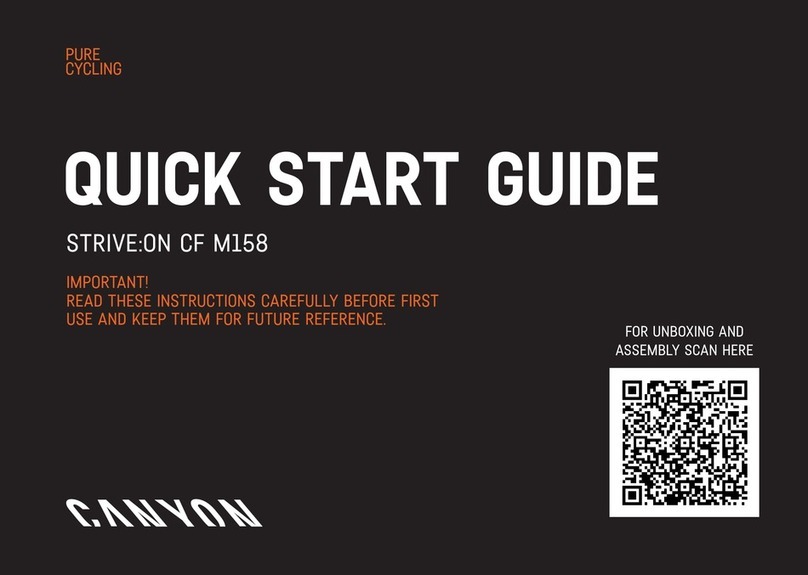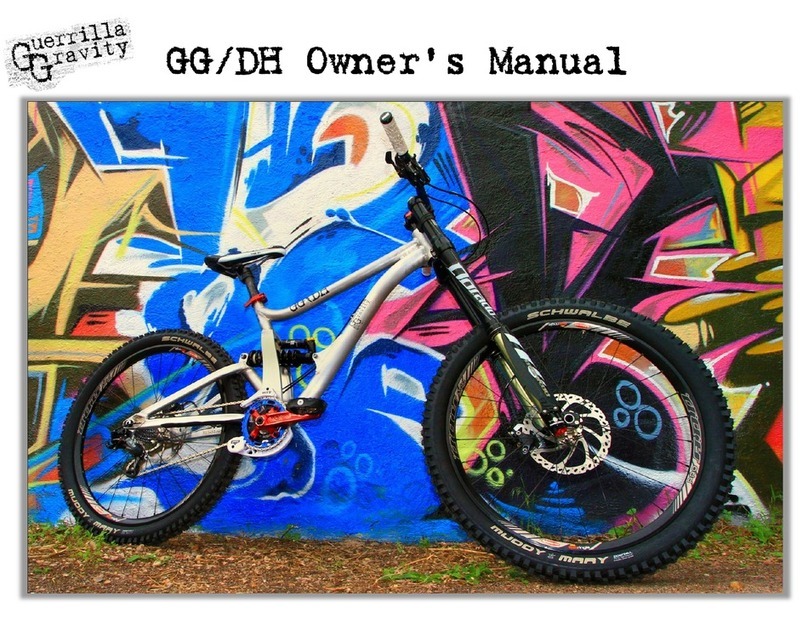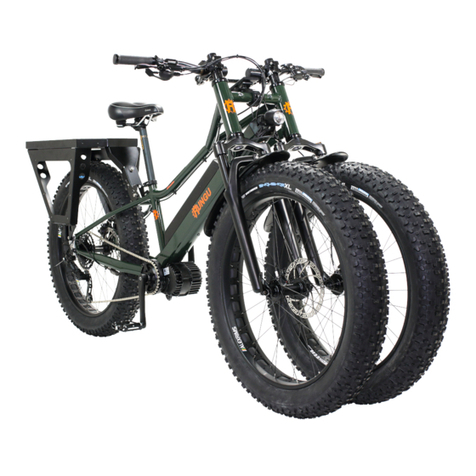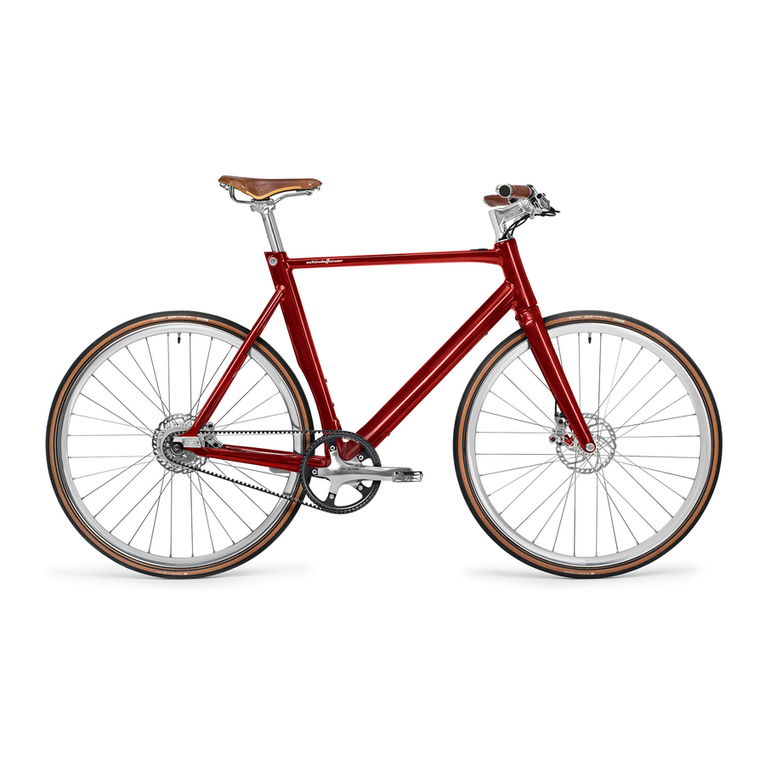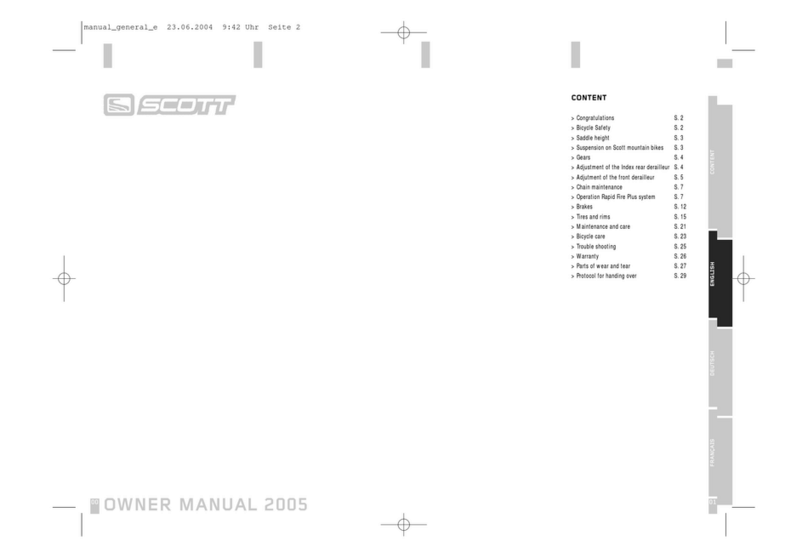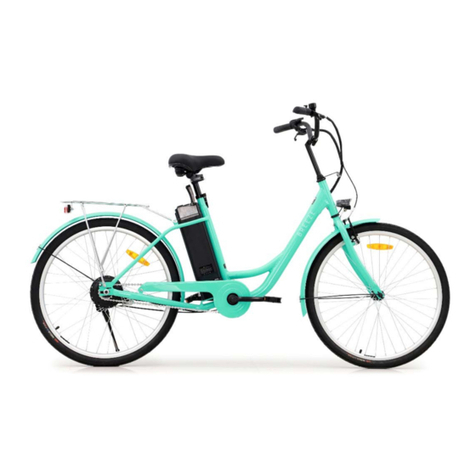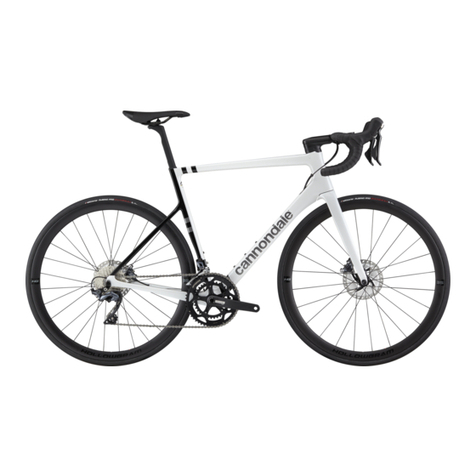Prodeco Technologies Phantom X R User manual

Some of the content of this manual may differ from
your bicycle depending on the options of the bicycle
and what your dealer provided.
© 2015 PRODECO TECHNOLOGIES. All rights
reserved. PRODECO TECHNOLOGIES and the
PRODECO TECHNOLOGIES logo are trademarks of
PRODECO TECHNOLOGIES. Printed in USA.
USER GUIDE
V
V
V5
5
5
IMPORTANT: ALUMINUM FRAME. NOT INTENDED
FOR HARD RIDING. DO NOT JUMP OR HIT
CURBS, AVOID IMPACTS. INSPECT FRAME FOR
FRACTURES. SERIOUS BODILY HARM CAN
OCCUR IF MISUSED.
SEE MANUAL FOR ADDITIONAL INFORMATION.

2
Table of Contents
1) Chapter 1: Introduction ……………………………………………………………………………………………….. 4
a. About this manual ………………………………………………………………………………………………….. 4
b. Important notices ……………………………………………………………………………………………………4
c. General warning …………………………………………………………………………………………………….4
d. A special note to parents ………………………………………………………………………………………….. 5
2) Chapter 2: Getting Started …………………………………………………………………………………………… 5
a. Familiarize yourself with your bicycle’s parts …………………………………………………………………… 5
b. Contents of the box ………………………………………………………………………………………………... 6
c. Registering your new bike ………………………………………………………………………………………… 6
d. Unpacking your box ……………………………………………………………………………………………….. 6
e. Installing the front wheel ..………………………………………………………………………………………… 6
f. Installing and adjusting the handlebar/stem .……………………………………………………………..…….. 7
g. Installing the pedals ………………………..……………………………………………………………………… 7
3) Chapter 3: Battery Management …………….……………………………………………………………………… 8
a. About the battery ….…….…………………………………………………………………………………………. 8
b. Charging the battery …..………………..………………..………………………..………………………………. 8
c. Installing the battery ………………………..…………....………………………..………………………………. 9
d. Removing the battery ……………………………………………………………………………………………… 10
e. Powering the battery ON / OFF …………………………………………………………………………………...10
f. Battery Fuse …………………………………………………………………………………………………………10
g. Storing the battery ………………………………………..………………………..………………………………. 10
h. Battery power indicator ………………………..………………………..………………………………………….10
i. Battery replacement ……………….……………………..………………………..………………………………. 11
j. Battery disposal …………………………………………..………………………..………………………………. 11
4) Chapter 4: Electrical Components ………………………………………………………………………………….. 11
a. Hub motor ………….…….…………………………………………………………………………………………. 11
b. Brushless hall sensor controller ……………….………..………………………..………………………………. 11
c. Throttle ………………………..………………………..………………………………………………………...…. 12
5) Chapter 5: Basic Instructions ……………………………………………………………………………………….. 12
a. Bicycle fit ……………………………………………………………………………………………………………. 12
b. Adjusting the saddle …….…………………………………………………………………………………………. 12
c. Your local electric bicycle and bicycle laws …………………………………………………………………..….13
d. Safety first …………………………………………………..………………………………………………………. 14
e. Mechanical safety check ………………………………………………….………………………………………. 14
f. Riding an electric bicycle ……...……………………………………………..…………………………………….15
g. Safe riding in various conditions ……………………………………………………………………………….….15
h. Watching for obstacles around you ……………………………………………………………………………….15
i. Before your first motorized ride ……………..……………………………………………………………………. 15
j. First motorized ride ……………..…………………………………………………………………………………. 15
k. Using your twist throttle …….……..………………………………………………………………………………. 16
l. Using your brakes …………….…………………………………………………………………………………….16
m. Pedaling ……………………….……………………………………………………………………………………. 16
n. Shifting gears ………………………………………………………………………………………………………. 16
6) Chapter 6: Safety ………………………………………………………………………………………………………. 17
a. The basics ………………………………………..………………………………………………………………….17
b. Riding safety ………………………..………………………………………………………………………………. 17
c. Wet weather riding ………………………………………………………………………………………………….18
d. Reflectors ……………………...……………………………………………………………………………………. 18
e. Night riding …………….…………………………………………………………………………………………….18
f. Adding accessories ……..…………………………………………………………………………………………. 18
7) Chapter 7: Perfect Fit and Ride ……………………………..………………………………………………………. 18
a. The basics …………………...……..………………………………………………………………………………. 18
b. Frame size ………………………..……………………………………………………………………………...….19
c. Recommended sizing ……………..………………………………………………………………………………. 19
d. Control position adjustments ………………………..……………………………………………………………. 19
e. Brake lever height adjustments ………………………..…………………………………………………………. 19
f. Suspension fork adjustment ………………………..……………………….……………………………………. 19

3
8) Chapter 8: Tire, Tube, Wheel or Axle Repair ……………………………………………………………………… 20
a. Removing the rear motor wheel ………………………..………………………..………………………………. 20
b. Installing the rear motor wheel ………………………..……………………………………………………….….20
c. Removing and installing the front wheel ……………………..………………………………..……………..…. 21
d. Replacing a tube or tire …………...………………………………………………………………………………. 22
9) Chapter 9: Maintenance and Replacement ………...………………………………………………………………23
a. Keeping your bike clean ………………..………………..………………………..……………………………….23
b. Avoid scratching your bike …………………..…………..………………………..……………………………….23
c. Brake bed-in and adjustments ………………………………………..…………..……………………………….24
d. Brake pad replacement ………………………………….………………………..………………………………. 25
e. Derailleur adjustments ………………………..…………………………….……..………………………………. 25
f. Wheel check ………………………………..……………..………………………..……………………………….27
g. Lubricating ………………………..…………………………….…………………..………………………………. 27
h. Crankset …………………………………….……………..………………………..……………………………….27
i. Pedals ……………………………………………………..………………………..………………………………. 27
j. Headset …………………………………..………………..………………………..……………………………….27
k. Maintenance schedule …………………………….……..………………………..……………………………….28
l. Torque specifications for common parts ……………....………………………..………………………………. 28
10) Chapter 10: Warranty Service and Repair ………………………………………………………………………….29
a. 2 year limited warranty …………………………………..………………………..………………………………. 29
b. Registering your bike ……..…………………….………..………………………..……………………………….30
c. Serial numbers and where to find them ………………..………………………..………………………………. 30
d. Registration card …………………..……………………..………………………..………………………………. 30
e. Part replacement procedure …………...………………..………………………..……………………………….31
f. Contacting Prodeco Technologies ……………………..…………….…………..……………………………….31
11) Chapter 11: Specifications …………………….………………………………...……………………………………31
12) Chapter 12: Parts ……………………………………………………..…….…………………………….…………… 32

4
OPERATIONAL INSTRUCTIONS
Chapter 1: Introduction
Prodeco Technologies thanks you for your purchase of your new Phantom X R. Your bicycle is a high quality and
environmentally friendly light electric vehicle. This manual will serve to provide you with the information needed to
operate, maintain and enjoy it safely. Your electric bicycle should provide you with years of healthy enjoyment provided
you follow these steps.
For technical questions or customer service, please contact PRODECO TECHNOLOGIES at 800.943.6190 or e-mail us
at service@prodecotech.com.
a) About this manual
To prevent serious injury to yourself and others, and to prevent damage to the bicycle please read and understand
these instructions completely before operating your Prodeco Technologies Phantom X R. Your new bicycle is a
powerful and reliable electric bicycle. You should use caution and care while getting accustomed to your bicycle’s
riding characteristics. The following manual will provide basic instructions regarding your bicycle’s care and
maintenance, battery management, operating procedures, and other important information. You should read it
thoroughly before riding your new bicycle for the first time. If you have any questions that are not answered in this
manual, contact your local authorized Prodeco Technologies dealer or you can call customer service at 800.943.6190.
b) Important notices
Turn offthe batterywhen your bicycleis notin use.
Thebatterymust beremovedwhenreplacing acomponentor performingmaintenance.
Makesure your electric bicycleis properlyfitted to you as described in Chapter 5 “Basic Instructions” section a).
Perform the mechanical safety check described in Chapter 5 “Basic Instructions” section e) “Mechanical safety
check” beforeeachride.
You should ride your Phantom X R as atraditionalbicycle under pedalpowerprior to ridingunder motor power for thefirst
time.Thiswill allowforthe familiarization of how your Phantom X R rides and balances.
When riding under power for the first time, twist the variable throttle very slowly only after pedaling to a slow speed to
understandthe strength of the front motor’s performanceand griponthe roadsurface.
Always applyfull front & rear brake lever pressure when attemptingto mount or dismount the bicycle.
When attempting to mount or dismount the bicycle, the throttle red button should be in the off position (out) and the
batteryswitchpressed off.
Please read the battery pack and detailed charging instructions found in Chapter 3 “Battery Management” before
chargingthe batterypackfor the firsttime.
You should fullycharge the Li-ionbatteryaccording to thecharging instructions before your firstride.
You should always fullycharge your Li-ion batteryevery 10 miles regardless of the amount of small tripdistances.
Alwaysstorethe batterypackina cooland dryplace.
During periods of prolonged storage, the batterypack should be charged at least once every 4 months at a minimum of
60%or every2 monthsat40%.Donotchargehigherthan60%whenstoring.
Your Phantom X R can be ridden as a traditional bicycle; it is strongly recommended that you also assist with pedaling
when ridingwhich can greatlyincreasethe distancebetweenbatterycharges.
When ridingunder power,you can enhance distancein between charges byholdingthe throttleat 10%belowfull throttle.
When riding under power, add as much non-powered coasting (similar to traditional pedaling) byreleasing the throttle and
allowingthebicycleto freelycoastunderitsownmomentum.Thiswillgreatlyincreasethe distancebetweencharges.
Familiarize yourself with throttling (10% below full), pedaling and momentum coasting to optimize the distance being
available per charge. If planning a long trip, applying a combination of the 3 distance enhancing methods mentioned
above willallowfor an uninterruptedpowersupplyfor theentireride.
c) General warning
Like any sport, bicycling involves the risk of injury and damage. By choosing to ride a bicycle, you assume the
responsibility for that risk, so you need to know —and to practice —the rules of safe and responsible riding and of
proper use and maintenance. Proper use and maintenance of your bicycle reduces risk of injury.
This Manual contains many “Warnings” and “Cautions” concerning the consequences of failure to maintain or inspect
your bicycle and of failure to follow safe cycling practices.
WARNING: This image followed by the word WARNING indicates a potentially hazardous situation that,
if not avoided, could result in serious injury or death.
CAUTION: This image followed by the word CAUTION indicates a potentially hazardous situation, which,
if not avoided, may result in minor or moderate injury, serious, damage to the bicycle or the voiding of your
warranty or is an alert against unsafe practices.
Many of the Warnings and Cautions say, “you may lose control and fall”. Because any fall can result in serious injury or
even death, we do not always repeat the warning of possible injury or death. Because it is impossible to anticipate every
situation or condition that can occur while riding, this Manual makes no representation about the safe use of the bicycle
under all conditions. There are risks associated with the use of any bicycle which cannot be predicted or avoided, and
which are the sole responsibility of the rider.

5
d) A special note to parents
The ProdecoTechnologies Phantom X R isintended for use byadult riders only. Many state laws require electric bicycle riders
to be aminimum age of 16 with some states having minimum ages set as low as 10 years old and other states up to 18 years
old (at the time of the writing of this manual). As a parent or guardian, you are responsible for the activities and safety of your
minor child including the following of your state and local laws in regards to the riding of an electric bicycle by a minor (under
the age of 18).That includes, if your state allows a minor toride,making sure that your minor child can safely ride and control
allof the operations of the bicycle, and fullyunderstands all warnings and cautions as indicated in this User Guide. Please read
on if you have determined that your minor child can legally and safelyride and control all of the operations of the bicycle. That
includes makingsure that thebicycle is properly fitted to the child; that it is in goodrepair and safe operatingcondition; that you
and your child have learned and understand the safe operation of the bicycle; and that you and your child have learned,
understand and obeynot only the applicable local motor vehicle, bicycle and traffic laws, but also the common sense rules of
safe and responsible bicycling. As a parent or guardian, you should read and understandthis manual. Before letting any child
ride the Phantom X R or anyof Prodeco Technologies electric bicycles, review with them all warnings and cautions; as well as
the information on the proper usage of your battery pack, charger and bicycle. You must first confirm the laws, rules and
regulations regarding electric bicycles in your state, cityand local municipality.
WARNING: Make sure that your child always wears an approved bicycle helmet when riding; but also
make sure that your child understands that a bicycle helmet is for bicycling only, and must be removed when not
riding. A helmet must not be worn while playing, in play areas, on playground equipment, while climbing trees, or
at any time while not riding a bicycle. Failure to follow this warning could result in serious injury or death.
Chapter 2: Getting Started
a) Familiarize yourself with your bicycle’s parts

6
b) Contents of the Box
Check the contents of your box. Your new Phantom X R should include the following items in the box or your dealer
should have included these items with your purchase:
Phantom X R Bicycle
Velo Plush Saddle and Seat Post
ProdecoTech 36V 14Ah Li-ion Battery
ProdecoTech 36V 2A Li-ion Charger
Two Battery Lock Keys
Full size hex keys (2.5, 3, 4, 5, 6 & 8mm)
Philips Head #2 Screwdriver
Torx T25 Driver
c) Registering your new bike
For the warranty to take effect, you must register your new bicycle. Registration of your electric bicycle is the only way we
can acknowledge and verify the established owner. Your bicycle has 3 individual and unique serial numbers (frame,
motor and battery). Each serial number must be registered when filling out the registration form. The serial number on
the frame is located under the crank/bottom bracket portion of the frame. The serial number for the motor is found on the
motor’s side. The serial number for the battery is located on the barcode label adhered to the underside of the battery.
These numbers should be recorded and registered in case of warranty issues or theft. Please review Chapter 10
“Warranty Service and Repair” section c)“Registering your bicycle” how to register your Phantom X R. You can
register by either filling out the online registration form at www.prodecotech.com/register-your-ebike/ or by sending the
registration card found in Chapter 10 “Warranty Service and Repair” section d) “Registration card”.
CAUTION: If you have purchased your bicycle by mail order or through a sales channel whereas your new
Phantom X R is still in the box, it is recommended you read Chapter 5 “Basic Instructions” section i) “Before your
first ride” prior to your first ride. There may be additional adjustments required due to shipping by the freight carrier.
d) Unpacking your box
Your Phantom X R arrives fully assembled in it’s box. It may require the front wheel, stem and seatpost to be installed.
To install the front wheel, read the following section e) Installing the front wheel. The stem installation is detailed
afterwards in section f) Installing the stem. You can learn how to insert the seatpost and adjust for your height in
Chapter 5 “Basic Instructions” section b) “Adjusting the saddle”.
The Phantom X R has been tested and adjusted prior to being packageded. To remove the Phantom X R, open the top
flap of the box and remove the protective top insert. Place one hand under the front portion of the frame and the other
hand under the center of the frame. Pull up slowly and the bicycle will lift out of the box. Remove the additional inserts
and set the bicycle down by balancing the bicycle on the opened kick stand and rear wheel. The kick stand also performs
as a crankset protector.
e) Installing the front wheel
The front wheel on the Phantom X R can be installed without tools. A quick release skewer
through a hollowaxle is utilized for easyand quick wheel installation. A quick release skewer
is a rod that has a threaded acorn nut on one end and a cam lever assembly on the other
end. Thecam leverappliespressureandlockstheaxleinplace.
When installing the wheel for the first time, you must first remove the plastic brake
pad spacer as shown in the right side photo by pulling the spacer out. Follow these
instructions to install the wheel:
1. Slide the wheel axle into the fork dropouts while aligning the wheel straight.
2. Install the axle quick release skewer.With the quick release fullyopen, tighten the
acornnut until a slightresistance. Confirm axle is fully seated in the fork’s dropout.
3. Once tightened, close the quick release lever with enough force to clamp and
lock the axle into the dropouts. The force must be strong enough for the axle
not to become loose. It should take some effort to close the lever but not so
much that you are straining. Once closed, you should not be able to easily
open the quick release lever.
4. Test to see if the quick release lever will open with 1 finger. If it opens, you must
performthepreviousstepagain untilthe quick releaseleverclampis tight.

7
f) Installing and adjusting the handlebar/stem
The handlebar of the Phantom X R is shipped detached from the stem
and temporarily secured to the frame with shipping ties. To install the
handlebar and adjust the stem to a comfortable riding position, you will
need to use the 4mm, 5mm and 6mm Hex Wrenches included with your
bike. The 4mm is required to tighten the binder bolts, the 5mm will
tighten the steerer tube bolts and the 6mm will allow you to adjust the
angle of the stem.
Start by cutting the shipping ties to free the handlebar from the frame.
Then place the center of the handle into the stem’s concaved center.
Secure the handlebar clamp plate to the stem with the included 4mm
hex wrench or preferably a torque wrench. There are 4 stem binder
bolts which tighten the clamp plate to the stem. You will also want to
rotate the handlebar to a comfortable riding position prior to the final
tightening / torqueing of the stem binder bolts. The stem binder bolts
require torqueing of a minimum 60 lb*in. The brake levers, throttle and
shifter positions can be adjusted afterwards for proper control.
The stem’s angle can also be adjusted for rise. When adjusting the
angle, the stem will rotate closer to the rider allowing for a more
upright riding position. The angle adjustment bolt is torqued and
tightened at the factory prior to shipping. If changing the angle of the
stem, you must properly tighten this bolt afterwards. A loose angle
adjustment bolt can become very dangerous during a ride if the stem
drops from not being properly tightened. To adjust the angle of the
stem, locate the adjusting bolt on the right side of the stem. Use the
included 6mm hex key to loosen the adjustment bolt. Pivot the stem to
the desired riding position and tighten the angle adjustment bolt. A
torque wrench is suggested and the angle adjustment bolt should be
tightened to 180lb*in.
The last bolt allowing for an adjustment is the stem’s steerer tube bolt.
To loosen or tighten this bolt, the 5mm hex key will need to be used.
The steerer tube bolts grip and secures the stem around the fork’s
steerer tube. To align the stem to the front wheel, the steerer tube
bolts need to be loosened, the stem aligned and the bolts tightened.
The steerer tube bolts require an 80lb*in torque.
WARNING: The handlebar controls will be rotated upwards
changing the angle of the stem. Loosen the 4 stem binder bolts and
rotate the handlebar downwards to a preferred riding position. Tighten
stembinderboltsto60lbs*in.
CAUTION: The stem steerer, top cap and angle adjustment bolt
must be checked for tightness to ensure the handlebar stem will not
loosen accidentally and either the handlebar does not turn the wheel or
the stem angle falls upon riding. Failure to tighten can cause a rider to
losebalanceandmayresult in afall.
g) Installing the pedals
Installation and removal of pedals is a fairly simple process with
the included 6mm Hex Key wrench. The pedal axles are made of
cromoly steel and the cranks arms are made of aluminum.
Therefore, there is a possibility that the hard pedal threads may
strip the soft aluminum threads. The important thing to remember
is to line up the treads properly and never force the parts to
move. The right drivetrain side pedal has regular threading. It
turns clockwise as you tighten it and turns counter-clockwise as it
is loosened. The left side pedal is the opposite. It turns counter-
clockwise as you tighten it and turns clockwise as it is loosened.
The Pedal spindles are marked with “R” for “Right” and “L” for
“Left”. The right pedal axle should be installed on the bicycle’s
right crank arm. Initially, gently install it with your hands turning
the pedal axle toward the front of the bike. Once it is lined up and
turned as far as you can turn it by hand on the crank arm, use the
ProdecoTech hex tool / wrench to fully tighten the pedal. The hole
for this tool will be in the end of the pedal axle.
Repeat the same process for the left axel. The left axel pedal also
requires gentle turning toward the front of the bike. If the pedal
doesn’t turn, don’t force it. Verify that you are installing the right
pedal on the right side of the bike or the left pedal on the left side
of the bike.

8
Chapter 3: Battery Management
a) About the battery
The Phantom X R’s battery cell system is composed of 50 x Samsung’s Highest Grade NCA 18650 Lithium Nickel
Cobalt Aluminum Oxide (LiNiCoAlO2) Cells. These are the same type of cells found in Tesla EV’s. They offer high
specific energy, good specific power and high number of charge cycles. To increase charge cycles to 1000 vs an
industry average of 600, ProdecoTech reduce the charge cut off from 42V to 41V. Lithium cell degradation
accelerates at the charging space of 95% to 100% and drastically reduced when lowered.
The battery is a removable device and can be charged on or off the bicycle. The battery is sealed and maintenance
free, you must never open the battery as this will void the warranty. Each battery has a specific serial number and
barcode which can be found on the underside of the battery. Please read the warning labels on your battery and
follow these instructions. If removing the battery to charge it, review section d) on how to remove your battery.
b) Charging the battery (SEE PHOTOS THIS AND NEXT PAGE)
You will need to charge your battery prior to powering the bike for the first time. The battery may be in hibernate
state which could take over 8 hours for the initial charge. The managed charge is designed to extend the life cycles
of the battery. The Battery Management System incorporates a Cell Balancing feature and the initial charge should
not be rushed.
Charge your battery as follows:
1. Confirm the battery is OFF (No LED Lights) by pressing the ON/OFF rubber panel switch at the top of the
battery. The LED indicator lights may or may not come on depending on the state of the battery.
2. Lift the charging port rubber cover open at the bottom of the battery, exposing the DC 2.5mm Power Jack
(charging port). There is also a 5v USB power source/communication port. Do not use the USB port other
than to power a light or charge a cell phone. The USB 5V is for convenience and not guaranteed to power.
3. Plug the charger into a wall outlet and confirm the charger is OFF. The LED light on the charger will display
as clear when OFF. When ON the light will display green and when charging, it will display red.
4. Plug the DC 2.5mm Jack into the battery charging port, confirming a tight connection.
5. Turn the charger ON via the ON/OFF switch located on the charger power cord. The charger light will
display red as it starts charging. Upon being fully charged (up to 8 hours initially), the charger will light
green.
6. Upon the battery being fully charged, turn the charger OFF via the ON/OFF switch located on the charger
power cord. Disconnect the charger from the battery.
7. NEVER leave the charger connected to the battery upon the battery being fully charged. As the battery
drains via the BMS (Battery Management System), the charger will continuously charge the battery. This is
not good for lithium batteries and will decrease the life of the battery.

9
c) Installing the battery (SEE PHOTOS)
The Phantom X R’s battery mounts on the downtube of the bicycle from the left side. To mount the battery, you
would first slide the base of the battery into the frame’s lower docking mount (closest to the crankset) and then
move the battery sideways into the lock position. The battery will be a tight fit and ALWAYS confirm the battery is
locked in place by pulling the top of the battery sideways. By pulling on the battery, this will assure the battery has
locked into position. Review the photos and detailed explanation of how install the battery below.
The battery is secured in place at the base by a round elbow combined with a securing mount. At the top, the
battery is secured by a spring loaded cylinder latch. It is IMPORTANT you ALWAYS confirm the battery is locked in
place. Follow these instructions to install and lock the battery in place.
1. Confirm the battery is in the OFF position (No LED lights) by pushing the rubber panel switch at the top
of the battery.
2. Hold the battery parallel to the downtube opening, this is where the battery will mount.
3. Angle the bottom of the battery towards the frame’s lower docking mount.
4. Sit the battery base’s round elbow into the round concave space at the frame’s lower docking mount.
5. Slowly place the battery into position by moving the battery sideways, seating it into the frame’s
downtube.
6. Firmly push the side of the battery top to lock the battery in place. The spring loaded latch should have
locked the battery in place.
7. Confirm the battery is locked in place by pulling at the top of the battery as if you were going to remove
it. If the battery moves even the slightest amount, the battery is not locked in place. Remove and
reinstall the battery if the battery did not lock in place.

10
d) Removing the battery (SEE PHOTOS)
The battery locking system is a simple spring loaded latch. The latch (cylinder bolt) is controlled via a key lock
mounted on the left side of the frame’s down tube. When the lock’s keyhole is vertical (12 o’clock position), the
battery is locked in. When the keyhole is turned clockwise horizontally (3 o’clock position), the battery can then be
released. Turn the key clockwise to release the spring latch and pull on the battery to remove.
e) Powering the battery ON / OFF (SEE PHOTOS)
The key to the Phantom XR is only to Unlock and Release the battery. The key does not power the battery ON or OFF.
To power the battery ON or OFF, simply push the rubber panel switch at the top of the battery. The LED lights will come
on and display battery capacity. If the battery is mounted on the bicycle, the Throttle LED lights will also light up. If the
batteryor throttle LED lights do notcomeon, charge the battery for a minimum of 8 hours as outlined in section b).
f) Battery Fuse
On the rare occasion the battery does not charge after 8 hours, the fuse or charger
may need to be replaced. The fuse is an automotive 30A Blade fuse and located at
the bottom side of the battery. (SEE PHOTO)
g) Storing the battery
The Li-ion battery the Phantom X R utilizes is the latest technology in Li-ion battery
cells. It is recommended that you do not store the battery in hot conditions. If the
bicycle is being stored indoors in a cool environment, the battery should be stored
on the bicycle in the “OFF” position. The battery should be kept away from fires or
sparks and also away from possible water damage. The battery is water resistant
and not water proof. Avoid wet conditions such as rain or cover your battery in the
rain. Store the battery in a cool dry place and charge to a maximum 80%
every 90 Days.
h) Battery power indicator
The Phantom X R has a 3 LED light indicator on the handlebar throttle
displaying the battery capacity available. The LED indicator on the throttle is
explained in Chapter 4: Electrical Components, section c) “Throttle”.
There is also an LED battery indicator on the battery itself. The indicator on
the battery has 4 LEDs lights displaying 4 levels of remaining voltage. When
pressing the Battery ON / OFF rubber panel switch at the top of the battery
to the ON position, the indicator will light 1, 2, 3 or 4 LED lights according to
the remaining voltage in the battery. 4 LED lights if 75% to full charge.
The voltage needed to power the motor is a minimum of 30V. When the
battery is depleted to 30V, all LED lights will turn OFF and the battery will
shut down. If only 2 LED lights remain, the battery is now at > 50%
depletion and must be recharged.

11
i) Battery replacement
If your battery is no longer working properly and needs replacing, you can contact your local authorized dealer for a
replacement or contact Prodeco Technologies directly. Contact service@prodecotech.com or call 800-943-6190 to
discuss the issue and determine if it is the battery. It is very rare for the battery to have an issue in the first 2 years
and there may be another situation with the bicycle rather than the battery if not powering properly. The battery is
covered under warranty for the first 2 years of use. After 2 years, a replacement battery can be purchased by
contacting your dealer or Prodeco Technologies. The battery part number and price can be found in Chapter 12.
j) Battery disposal
The battery that comes with your Phantom X R is recyclable. When the battery is no longer strong enough to power
the bicycle, it may contain cells which could subsequently be utilized to power battery storage banks or used
individually. The battery should be recycled and disposed of by the following means:
Return the battery to your local authorized Prodeco Technologies dealer.
Return the battery directly to Prodeco Technologies.
Drop off to a local specialized battery service and sales center such as Batteries Plus™.
Dispose of the battery at your local city recycling facility.
Chapter 4: Electrical Components
The Phantom X R electric components were developed to be maintenance free with no serviceable parts. There
are 5 components used to power your bicycle. Each component can easily be replaced by the average person with
minimal mechanical skills. The design has been simplified so your local bicycle shop can service it without issue
and minimal time. Please review the sections below on the electrical components used on your ProdecoTech
bicycle and how to replace a component for a new one. Each electrical component is listed, except for the battery
which was detailed in Chapter 3. Each individual component part number can be found in Chapter 12.
a) HUB motor
The HUB motor utilized on your Phantom X R is one of the most advanced e-bike HUB motors developed today. It
is a high efficiency, high torque brushless planetary geared motor with a freehub spinning cassette spindle. The
motor will spin freely, the same as a traditional bike hub, only engaging when the throttle is applied. You will be able
to pedal and coast your bike the same as a traditional non-electric bike when choosing not to throttle.
The motor is held in place at the frame’s rear dropouts. The dropouts incorporate ProdecoTech’s uniquely designed
stainless steel axle plates which have been specifically engineered to spread the torque of the motor through the
dropout and rear stays. The stainless steel plates further act as safety devices strengthening the rear aluminum
dropouts. When installing the motor, you must always install the axle plates.
The motor offers a nominal 600W of power at 36 Volts and a peak of 828W (1.1hp). The power is sufficient to move
the bicycle and rider on flat surfaces at speeds up to twice what a typical rider pedals. Steep inclines may require
pedaling by the rider to power over the incline as not to overheat the motor. It is highly suggested the rider pedals
along with the motor to enhance traveling distance even on flat surfaces. The motor is powered through a “Hall
Effect Sensor” approach. A “Hall Effect Sensor” motor is powered in multiple stator phases. As power is phased,
the motor stator rotates engaging the planetary gears and moving the bike forward. The Hall Sensors monitor the
stators position. The axle of the motor is the spindle of the planetary gear system. The inside of the hub is lined with
an inverted gear, spinning the motor forward.
A weatherproof connector at the motor connects the wiring harness to the motor. This connector is an 8 pin brass
connector and designed to withstand the elements. If the motor needs to be replaced, the connector simply has to
be unplugged for the motor to be removed as explained in Chapter 8, section a). When installing the motor, it is
very important the connector is plugged properly or the motor will not power. There are 2 arrows, one on each end
of the connector which must align. There is an additional line on the inside connector which must meet the edge of
the outside connector when inserting for the motor to have a solid connection.
b) Brushless hall sensor controller
The Phantom X R motor requires a specific controller to
produce the proper “Hall Sensor Effect” as described in the
previous section. The controller is considered the brains of
the bicycle and is located at the top of the down tube
behind the top battery mount. It manages speed and pulls
the correct amount of Amps from the battery to power the
motor sufficiently based on the position of the throttle. The
controller has been designed to be easily changed if an
issue was to occur. To access the controller, you would
need to remove the top of the battery mount with a Philips
screwdriver. The controller has 3 unique connections:
Motor, Throttle and Battery. You cannot make an error
when connecting or disconnecting the controller due to the
unique connections. The controller connects directly to the
motor at the motor itself. See Chapter 8, section a) to
disconnect the motor.

12
c) Throttle (SEE PHOTO)
The variable throttle included with all ProdecoTech
bicycles has an On/Off button. The red button below the
battery indicator on the throttle engages the power to the
motor. The twist throttle was designed to allow you the
ability to choose the riding speed and determine the
amount of torque off the line. Similar to an automobile, the
throttle mimics the depressing of the accelerator. The
higher the speed, the less distance per charge (less
distance per gas tank), the faster you accelerate off the
line, the less distance per charge. If there are multiple stop
and starts, this will also affect the range of distance per
charge. It is recommended you become accustomed to
your riding style and adjust the style depending on
distance needed per charge. For example: if you are
planning a short local trip, full throttle at takeoff and top
speed will not be an issue due to your ability to be able to
recharge the battery prior to the next trip. If you are
planning a longer trip, 30-35 miles or more, it is suggested
you add pedaling, hold throttle back 10% and whenever
possible allow the bicycle to coast under no throttle power. Coasting under no power is similar to riding a traditional
pedal powered bicycle. When riding, a rider will pedal for a few seconds and then stop pedaling, allowing the bike
to coast with no power being used. This will greatly enhance your distance between charging.
The throttle incorporates an LED battery indicator to assist the rider with determining the amount of charge left in
the battery. You should also understand the LED indicators react according to load. There is 1 Green LED, 1
Yellow and 1 Red LED. If the Green LED no longer lights while the bike is not being powered, it is time to
recharge the battery. The Green LED does not always represent a fully charged battery though. For example, the
Green LED may be lit until a steep incline. As you ride up the incline, you may notice the Green LED will dim as
the motor increases the pulling of Amps from the battery. Depending on the load being placed on the motor and/or
grades of incline, the green LED dimming represents the accurate battery capacity. Upon the Green LED no
longer being lit during riding, particularly under no load, the battery should be charged prior to the next ride. If the
Green LED is dimming under light loads, the battery could be under 50% capacity and should be charged. After
multiple rides and charges, you will become familiar with the distance per charge available based on your riding
style and terrain. For rides close to home with nominal pedaling needed, you should attempt to fully discharge
your battery to enhance your understanding on distances per charge.
Chapter 5: Basic Instructions
a) Bicycle fit
It is very important your Phantom X R is properlyadjusted for comfort and to avoid the possibility of losing control while riding.
The saddle and handlebar have adjustments available to accommodate riders from 5’ 6” to 6’ 6”. There are saddle height,
saddle angle, saddle distance to steering tube, handlebar height and angle adjustment. If you plan to use your electric bicycle
also as a traditional pedal bicycle, it is recommended you adjust the saddle height to allow for a full leg extension when
pedaling. The ball of your foot when resting on the pedal should only allow for a slight bend at the knee when seated. Please
review the following points andsubsequent sections in determininghow to make the correctadjustments.
1) Isyourbikeadjustedtoyoursize?
2) Tocheck,seeChapter7“Perfect Fit and Ride”.Ifyourbicycleisnotproperlyadjustedforyou,youmaylosecontrolandfall.
3) Isthesaddleattherightheight?Tocheck,seeChapter7“Perfect Fit and Ride” sectiona)“Stand over height”.
4) Are saddle and seat post securely clamped? A correctly tightened saddle will allow no saddle movement in any direction.
SeeChapter5“Basic Instructions” sectionb)“Adjusting the saddle” for details.
5) Are the stem and handlebars at the right height for you? To check, see Chapter 7 “Perfect and Ride” section d)
“Handlebar height and angle”.Ifnot,seeChapter2“GettingStarted” sectionf) “Installingandadjustingthehandlebarstem”.
6) Canyoucomfortablyoperatethebrakes?If not,youhavetheabilitytoadjusttheirangleandreach.SeeChapter7“Perfect
Fit and Ride” section e)“Brake lever height adjustments” fordetails.
7) Do you fully understand how to operate your new bicycle? If not, before your first ride, have your dealer or contact us to
explainanyfunctionsorfeaturesthatyoudonotunderstand afterfullyreadingthismanual.
b) Adjusting the saddle
You have the ability to adjust the height of your saddle instantly via the quick
release clamp. There is also the ability to angle the nose of the saddle up or down
and adjust your riding position to be further or closer to the handlebar. The latter
two require the use of the hex key tools included with the purchase of your
Phantom X R. Please review the following details on adjusting your saddle.
Toadjust the height of the saddle or remove the seat post, no tools are required. The
quick release lever is opened by pulling the lever away from the seat tube allowing for
the seat tube clamp to loosen the grip around the post. This will allow you to raise or
lower the saddle to the desired height. There is a minimum insertion line on the seat
post which must be followed and you must not extend the seat post past this mark. It
is also important the seat tube clamp is tightened sufficiently around the seat post for
it not to slide downwards after the quick release lever is closed. This can be
accomplished by tightening the quick release nut clock wise which is located on the
opposite end of the quick release lever. WARNING & CAUTION (next page)

13
WARNING: The seat post includes a minimum insertion mark. It is important you do not allow the seat
post to be clamped below this mark. This mark must be inserted into the frame pass the top of quick release
clamp. If clamping below this mark, it can cause the seat post to break, failure to follow this warning could
result in serious injury or death.
CAUTION: The seat tube quick release clamp must be checked for tightness to ensure the saddle will not
accidentally slide into the seat tube when riding. This can cause a rider to lose balance and may result in a fall.
To tilt the nose of your saddle upwards or downwards, you will need to use the 5mm
hex key included with your multi-use tool kit that came with your bicycle. The saddle
mountingclamp attaches the saddle to the seatpost via afront andrear barrel nut and
bolt. To bring the nose of the saddle down, loosen the rear bolt by 1 full counter
clockwise rotation and tighten the front bolt by 1 full clockwise rotation. Check for
comfort and if the nose is still too high, attempt the above step again. Continue to
adjust by repeating the step above until the desired nose height is established. If you
prefer to raise the nose, you can follow the above step but in the opposite direction
(loosen the front bolt counter clockwise 1 rotation and tighten the rear bolt clockwise 1
rotation). All bolts should be tightened to 140 in*lb. (SEE PHOTO)
CAUTION: The saddle mount barrel nuts and bolts must remain tight at
all times. Test saddle for looseness or play in the rotation of the nose. If saddle
is loose, tighten the clamp bolts to ensure the saddle will not accidentally rotate
up or down when riding. Both bolts should be tightened to 140 in*lb. If loose,
this can cause a rider to lose balance and may result in a fall.
Your saddle can be adjusted to be closer or further away from the steering
tube/handlebar (you will need to use the 5mm hex key included with your multi-use
tool kit). This adjustment is minimal but allows a 7.5mm adjustment in either direction
from center mount (15mm total, close to 5/8”). To adjust the saddle closer or further,
you must loosen the rear and front barrel nut and bolt set which connects the saddle
rails to the saddle mounting clamp located at the top of the seat post. Loosen both
bolts by rotating 2 times counter clockwise each. This should allow for sufficient
looseness to slide the saddle rails in either direction on the saddle mounting clamp.
You must not allow the edge of the saddle mounting clamp to meet with the saddle rail
bends. The edge of the clamp must be a minimum of 5mm from the saddle rail bends.
Upon establishing the correct position,tighten the saddle mounting clamp bolts 2 times
in clockwise direction. Check for tightness of bolts and continue turning if loose. All
bolts should be tightened to 140 in*lb. (SEE PHOTO)
CAUTION: The edge of the saddle mounting clamp must have a minimum of 5mm of clearance from the
saddle rail bends. If the edge of the clamp is mounted to close the saddle rail bends and the rider does not
position themselves properly on the saddle, this could result in the rails becoming unstable due to the leverage
of the riders weight. The rails can bend and can cause a rider to lose balance and may result in a fall.
c) Your local electric bicycle and bicycle laws
Your new Phantom X R was designed to follow the federal guidelines to establish the Phantom X R as a traditional pedal power
bicyclewithinmostUSAstatesandtobeallowedtorideinbicyclepathways.However,electricbicycle laws change oftenand you
are responsible to confirm legal status of the riding of your electric bicycle in bicycle pathways. Belowis a referencesection onthe
USAelectricbicyclefederalguidelines:
Electric Bicycle Laws (please contact your local transportation department for the specific laws in your state and city regarding
ridingelectric bicycles onbikepathways)
Prodeco Technologies offers the following information as guidance and does not guarantee or assure riders they are
followingtherulesandregulations oftheirstate.
Electric bicycle laws may vary by state to state with most states following the classification of that bythe CPSC (Consumer Product
Safety Commission), DOT & NHSTA. Further, the US NHSTA (National Highway Traffic Safety Administration) defines low-speed
electricbicycles(under20mph)alsoasconsumerproductsandnotMotorVehiclesforsafetystandards.TheNHSTAadheresforthe
mostparttotheCPSCguidelines.WeincludedreferencebelowonhowelectricbicyclesareperceivedbytheFederalGovernment’s
mostimportantagencies.Wedobelievenewregulationandruleswillapplyinthefutureupontheelectricbicyclebecomingoneofthe
standard forms of transportation for the masses. Prodeco Technologies will continue to follow new rules and guidance set forth by
theseagencies,alwayswelcomingandadheringtotheguidelinestheyfeelarerequiredtoassuresafetyfortheelectricbicyclerider.
On October 22, 2008, the Federal Highway Administration (FHWA) updated the Bicycle and Pedestrian Provisions of
Federal Transportation Legislationto maketechnical corrections andclarifications.
Belowaretheimportantupdatesreflectingelectricbicycles:
Motorized Vehicle Use: In general, motorized vehicles are not permitted on non-motorized trails and pedestrian walkways funded
under Title 23. Exceptions to this general rule exist for maintenance vehicles; motorized wheelchairs; when State or local
regulations permit, snowmobiles; and electric bicycles (weighing under 100 pounds and a top speed of less than 20 miles per
hour); "and such other circumstances as the Secretary deems appropriate" (except the Recreational Trails Program which
specifically provides funds for motorized trails). In 2008, FHWA developed a Framework for Considering Motorized Use on Non-
motorizedTrailsandPedestrianWalkwaystoimplementthe"othercircumstances"provision.
Prodeco Technologies only offers electric bicycles that fall under the category of “weighing under 100 pounds and a top speed of
less than 20 miles per hour”. According to the DOT and NHSTA, Prodeco electric bicycles meet the exception of Motorized
Vehiclesandthereforecanberiddenonnon-motorizedtrailsandbikepaths permittingstateandlocallaws.

14
FrameworkforConsideringMotorizedUse on Non-motorizedTrailsandPedestrian Walkwaysunder23U.S.C. § 217
The purpose of this document is to provide guidance to Federal HighwayAdministration (FHWA) division offices and a consistent
framework fordeterminingwhentopermitanexceptionformotorizeduseon non-motorizedtrails andpedestrianwalkwaysunder
23U.S.C.§217(h)(5). The relevantlegislationreadsasfollows:
23 U.S.C. § 217. Bicycle Transportation and Pedestrian Walkways (h) Use of Motorized Vehicles.--Motorized vehicles may
not be permitted on trails and pedestrian walkways under this section, except for-- (1) maintenance purposes; (2) when snow
conditions and State or local regulations permit, snowmobiles; (3) motorized wheelchairs; (4) when State or local regulations
permit,electricbicycles;and(5)suchothercircumstancesastheSecretarydeemsappropriate.
(j)Definitions.--Inthissection,thefollowingdefinitionsapply:
(2)Electric bicycle.--The term "electric bicycle" means any bicycle or tricycle with a low-powered electric motor
weighing under100 pounds,withatopmotor-poweredspeednotinexcessof20miles perhour.
(4) Wheelchair.--The term "wheelchair" means a mobility aid, usable indoors, and designed for and used by individuals with
mobilityimpairments,whether operatedmanuallyormotorized.
Theabove23 U.S.C.§217 offers directionthatthe Prodeco ElectricBicycles areallowed onbike-paths(non-motorizedtrails)due
toProdecoelectric bicycles fallingundertheclassification of less than100pounds andunder20mph.
HR727
SECTION 1, CONSUMER PRODUCT SAFETY ACT
TheConsumerProductSafetyAct(15U.S.C.2051etseq)isamendedbyaddedattheendofthefollowing:
LOW-SPEED ELECTRICBICYCLES
SEC. 38.(a) Notwithstanding anyother provision of law, low-speed electric bicycles are consumer products within the meaning of
section3(a)(1)andshallbesubjecttotheCommissionregulationspublishedatsection1500.18
(a)(12)andpart1512of title16,CodeofFederalRegulations.
(b) For the purpose of this section, the term `low-speed electric bicycle' means a two or three-wheeled vehicle with fully operable
pedals and an electric motor of less than 750 watts (1 h.p.), whose maximum speed on a paved level surface, when powered
solelybysuchamotorwhileriddenbyanoperator who weighs170pounds,islessthan20mph.
(c) To further protect the safety of consumers who ride low-speed electric bicycles, the Commission may promulgate new or
amendedrequirementsapplicabletosuchvehiclesasnecessaryandappropriate.
(d) This section shall supersede any State law or requirement with respect to low speed electric bicycles to the extent that such
Statelaworrequirementismorestringent thantheFederallawor requirements referred to in subsection(a).
SEC.2.MOTORVEHICLESAFETYSTANDARDS.
For purposes of motor vehicle safety standards issued and enforced pursuant to chapter 301 of title 49, United States Code, a
low-speed electric bicycle (as defined in section 38(b) of the Consumer Product Safety Act) shall not be considered a motor
vehicleasdefinedbysection30102(6)of title49,UnitedStatesCode.
Local BicycleLaws
Most states have their own set of bicycle laws regarding traditional pedal powered bicycles. With most states recognizing electric
bicyclesas traditionalpedalpoweredbicycles youmustlearnthe applicable laws in your area. Your Department of Transportation
orCycleClubsinyourareawillhavethedetailsinvolvingriding a bicycle in your area and your city’s bike pathways. Requirements
for riding will change depending on location. Most cities requiring LED lights, hand signals, riding on the correct side of the road,
ridingbehindandnotparalleltoothercyclist,etc…
d) Safety first
It is important you follow your local bicycle laws but also it is important you ride safely. Below are examples of understanding
how to ride your new Phantom X R safely. Always wear an approved helmet when riding your bike, and follow the helmet
manufacturer’s instructions for fit, use and care of your helmet.
Do you have all the other required and recommended safety equipment for your area? It’s your responsibility to
familiarize yourself with the laws of theareas where you ride, and to complywith allapplicablelaws.
Do you know how to correctly check your wheel axle nuts? Do you understand proper braking techniques? Is your
saddle properly adjusted? Howdo you power your new electric bicycle? These are all questions you should have the
answers to prior toriding for the firsttime. This USER GUIDEwill answer most of thequestions youhave in regards to
your new bicycle and assist you in ensuring your electric bicycle remains safe to ride. You should first read the USER
GUIDE in its entiretyand familiarize yourself with your newbicycleprior to riding.
Forfurthersafetyguidelines, please readChapter 6: Safety
e) Mechanical safety check
Check the condition of your bicycle before every ride.
Frame and Fork: Do a detailed visual inspection and make sure there is no frame damage or fractures. View the
welds and tubes for any fracturing, cracks, gouges or damage. Pay close attention to the welds including axle
dropout welds. Check the fork for damage including the crown and bridge
Nuts, bolts and straps: Make sure nothing is loose. Lift the front wheel off the ground by two or three inches then
let it bounce on the ground. Anything sound, feel or look loose? Do a quick visual and tactile inspection of the
whole bike. Are there any loose parts or accessories? If so, secure them. If you’re not sure, ask someone with
bike experience to check.
Tires and Wheels: Make sure tires are correctly inflated, see Chapter 8. Check by putting one hand on the
saddle, and the other on the intersection of the handlebars and stem, then bounce your weight on the bike while
looking at tire deflection. Compare what you see with how it looks when you know the tires are correctly inflated;
and adjust if necessary. Are the tires in good shape? Spin each wheel slowly and look for cuts in the tread and
sidewall. Replace damaged tires before riding the bike. Spin each wheel and check for brake clearance and
side-to-side wobble. If a wheel wobbles side to side even slightly, or rubs against or hits the brake pads, take the
bike to a qualified bike shop to have the wheel trued.

15
Brakes: Check the brakes for proper operation. Squeeze the brake levers. Are the brakes properly releasing? All
control cables and hoses seated and securely engaged? Do the disc brake pads grasp the rotors within an inch of
brake lever movement? Can you apply full braking force at the levers without having them touch the handlebar? If
not, your brakes need adjustment. Do notride thebike until the brakes are properlyadjusted.
Quick Releases: Make sure seat post, rear axle and frame quick release levers are properly adjusted and all are
in the locked position.
Handlebar and saddle alignment: Make sure the saddle and handlebar stem are parallel to the bike’s center line,
clampedandboltstightenedenough so that you can’t twist them out of alignment. If not, align and tighten them.
Handlebar ends: Make sure the left handlebar grip and right throttle grip are secure and in good condition. If not,
replace them.
Battery Pack Attachment: When attaching the battery, always confirm your battery is firmly attached to your
bicycle before riding. To test the battery attachment, pull sideways at the top of the battery. If attached properly
you will not be ableto move the battery even the smallest amount. If not, the battery pack mayfall off the bike.
CAUTION: The braking of your bicycle is one of the highest concerns in safety. Proper brake lever
mounting and adjustment is crucial for your brakes to work properly.
WARNING: All Quick release levers must be closed and the clamps or axles tight. One loose quick
release lever can cause the rider to lose control and cause serious injury or death.
WARNING: Loose or damaged handlebar grips or extensions can cause you to lose control and fall.
Unplugged handlebars can cut your body, and can cause serious injury in an otherwise minor accident.
f) Riding an electric bicycle
Riding an electric bike is similar to riding a non-electric bike but there are some differences to note. An electric bike
is slightly heavier and requires more time to stop due to higher traveling speeds. Your bike is also equipped with a
powerful motor that provides a boost noticeable when starting from a stop. The boost is exhilarating, but you must
be comfortable with the sensation before riding in crowded or congested areas. To maximize battery life, assist with
pedaling, engage throttle to 90% or less and add considerable coasting with no throttle to your riding. Your battery
is a finite resource and proper riding techniques will prolong its distance per charge.
g) Safe riding in various conditions
Riders may find themselves riding in a condition they did not plan on encountering. It is important your new
Phantom X R is maintained properly for optimum performance. Please read Chapter 9 on the details required to
keep your electric bicycle at its best. An unexpected rain storm, snow flurry or night ride could arise during a day’s
trip and you should always be prepared. Please read Chapter 6 on Safety, so upon encountering an unexpected
riding condition, you will be confident and ready.
h) Watching for obstacles around you
Your new Phantom X R travels at higher speeds than most riders are accustomed to, when compared to pedaling a
traditional bicycle. It is very important you are aware of your surroundings and obstacles which may appear near
you. You must watch the road surface you are traveling on which could cause the tires to slip or cause a flat.
Examples are soft shoulders, rocks, pot holes, uneven paths, grates, construction sites. Due to the higher rate of
speed when riding under motor power versus pedaling, objects will advance into your path at a faster rate. Pay
attention to other riders in your area, automobiles, motorcycles, pedestrians, poles, intersections and road signs to
name a few. The Phantom X R resembles a traditional bicycle and people walking, driving or standing may not
realize you are on a motor powered vehicle and misjudge your traveling speed.
WARNING: Hitting a pot hole, soft shoulder or other road deviation may cause you to lose control, be
thrown and cause serious injury or death.
i) Before your first motorized ride
Before your first ride study this manual in its entirety. Make sure you are comfortable and confident when sitting on the
bicycle. If an adjustment does not feel right or something feels loose, check to ensure you are properly fitted to the bike and
do a mechanical safety check as explained in the previous section e).Make sure you fully charge your battery with the
appropriate charger included with your bicycle. Be sure to firmly attach the battery to the bicycle. Try to pull the battery off
the bike to confirm proper installation. Read Chapter 3, section c) again.
j) First motorized ride
When you buckle on your helmet and go for your first familiarization motorized ride on your new bicycle, be sure to pick a
controlled environment, away from cars, other cyclists, obstacles or other hazards. Ride to become familiar with the
brake levers against throttling, variable throttle performance while pedaling your new bike and not pedaling. The first
motorized ride should be initially pedaling and then slowly pressing down on the throttle to feel the engagement of the
HUB motor. Familiarize yourself with the sensation of power.
Familiarize yourself with the braking action of the bike. To test the brakes at slow speed, shift your weight toward
the rear and gently apply the brakes, rear brake first. Sudden or excessive application of the front brake could
pitch you over the handlebars. Applying brakes too hard can lock up a wheel, which could cause you to lose
control and fall, review section l) Using your brakes.
Your bike has a front suspension system, familiarize yourself with how the suspension responds to braking
application and rider weight shifts.
Check out the handling and response of the bike; and check the comfort.
If you have any questions, or if you feel anything about the bike is not as it should be, take the bike back to your
dealer for advice or contact Customer Service at Prodeco Technologies.

16
k) Using your twist throttle
The variable throttle on your Phantom X R was
designed to allow you the ability to choose the
speed to ride at and determine the amount of
torque off the line. The throttle operates similar to
an automobile; the twisting of the throttle mimics
the depressing of the accelerator. The throttle is
located on the right side grip and considered a half
twist throttle. It is a half twist, as only the inside
portion will twist to power the bicycle. The grip itself
will not twist. Using you forefinger and thumb, you
can safely twist the throttle to propel the bike
forward. A half twist throttle is used to avoid
accidentally twisting the full grip when mounting
and dismounting the bicycle. Your throttle also
includes a Power ON and Power OFF button. It is
the red button located underneath the LED lights.
Depressing the button in activates the throttle and
pressing the button out will deactivate the throttle.
The ON / OFF button is for further safety. There is also an LED set of lights which assist in determining the amount of
battery storage capacity remaining. This is discussed in further detail later in the manual. Throttling is an important
factor with any electric bicycle and the distance of traveling available per charge. The higher the speed, the less
distance per charge, the faster you accelerate off the line, the less distance per charge. If there are multiple stops and
take offs, this also affects the range of distance per charge. It is recommended you become accustomed to your style
of riding and adjust the style depending on distance needed per charge. For example: if you are planning a short local
trip, full throttle at takeoff and top speed will not be an issue due to your ability to be able to recharge the battery prior
to the next trip. If you are planning a longer trip, 10-15 miles or more, it is suggested you add pedaling, hold throttle
back 10% and whenever possible allow the bicycle to coast under no power. Coasting under no power is similar to
riding a traditional pedal powered bicycle. When riding, a rider will pedal for a few seconds and then stop pedaling,
allowing the bike to coast with no power being used. This will greatly increase your distance between charging.
l) Using your brakes
Your Phantom is equipped with a high performance Avid hydraulic disc brake system. The hydraulic front and rear
disc brakes allow your new Phantom to stop quickly and accurately. Larger than industry average Avid HS “Heat
Shedding” stainless steel disc rotors were utilized for their increased heat dissipation. One of the great features
associated with hydraulic brakes is no pad adjustments. Once the calipers are properly installed, there are no further
adjustments required as the pads wear. When properly mounted, the Phantom high performance disc brake system
offers tremendous stopping power. Prior to leaving the factory, the Phantom brakes were properly mounted and
tested. Disc brakes however do require a bed-in process which occurs naturally after 20-40 stops. It can be sped up
by following the bed-in guidelines detailed in Chapter 9 “Maintenance and Replacement”, section c)“Brake pad
bed in”. When braking, both brake levers should be applied simultaneously. Your left brake lever manages your front
brake and your right brake lever manages your rear brake. You should become accustomed to the stopping power of
each brake (front & rear). Test each brake separately in a controlled environment for their ability to stop the bicycle.
Front brakes when locked can cause the rear wheel to come off the ground and the rider can be thrown off the
bicycle. In emergency situations, apply pressure to each brake lever, shift your weight to the back of the bicycle and
only attempt to use full force on the front brakes when the bicycle is not stopping quickly enough. Always keep a safe
distance between other vehicles, pedestrians and other riders.
WARNING: Locking the front wheel during braking can cause the rear wheel to lift off the ground and
throw the rider off the bicycle. Both brake levers should be applied simultaneously. In an emergency situation
shift your weight to the back of the bicycle. Locking the front wheel can cause the rider to lose control, be
thrown off the bicycle and cause serious injury or death.
m) Pedaling
Pedaling your Phantom X R is the same as pedaling a traditional bicycle. It is recommended you add pedaling to the
power of the bicycle to enhance the distance per charge. The Phantom X R is a 8 speed bicycle and has the ratio of a
42T front chain ring (sprocket) against a 11-32T rear freewheel which is designed to offer an easy pedaling pace at
any speed from 1 MPH to 20 MPH. It is recommended on steep inclines, the rider utilizes the throttle to assist in
powering the bicycle up the incline and simultaneously drop the bicycle to a
lower gear. If a rider’s style of riding is throttle only with no pedaling, distance
per charge will be decreased on a steep incline, the rider is required to assist
the motor by pedaling to power up the incline.
n) Shifting gears (SEE PHOTO)
The shifting of gears is required to change the ratio of the rotation of pedaling to
allow more or less torque and lower or higher speeds according to one complete
rotation of the crank set. If requiring more torque, you will shift to a larger rear
sprocket for a higher rotation of pedaling to a lower speed of the rear wheel. To
switch to a larger rear sprocket, you will need to shift to a lower gear. Gear 1 is the
largest sprocket which is 32 Teeth and your lowest gear. One full crank rotation
creates a 1.3 turns of the rear wheel. For higher speeds from less rotation of the
crankset on flat pathways, you will shift to a smaller rear sprocket for a higher wheel
rotation to a lower crankset speed. To shift to a smaller sprocket, you will need to
shift to a higher gear. Gear 8 is the smallest sprocket with 11 Teeth and your
highest gear. One full crank rotation creates a 3.8 turns of the rear wheel.

17
Chapter 6: Safety
The manual has detailed safetyriding methods. In this chapter we will further discuss additional safety guidelines.
a) The basics
Below is a safety guideline according to the CPSC (US Consumer Product Safety Commission) in regards to riding a bike.
Always wear a helmet to help prevent head injuries.
Observe all traffic laws and signals, just as automobiles must do.
Don’t ride double or attempt stunts.
Ride near the curb in the samedirection as traffic.
Find alternate routes, rather than ride through busyintersections and heavy or high-speed traffic.
Walk -- don't ride -- your bicycle across busyintersections and left turn corners.
Avoid riding in wet weather. When wet, handbrakes may require a long distance to stop.
Avoid riding in the dark. If you do, be sure the bike is equipped with a headlight, a taillight and reflectors.
Apply retro-reflective trim to clothing, or wear reflective vests and jackets.
Avoid loose clothing or long coats that can catch in pedals or wheels. Leg clips or bands keep pants legs
from tangling in the chain.
Avoid crossing raised sewer grates.
Regular maintenance is essential for safe riding. Refer to the maintenance recommendations. If you do not
have basic mechanical skills, an authorized dealer should perform repairs and maintenance.
Align (or "true") wobblywheels for better control. Spokes also may need adjustment.
Replace all missing, damaged, or worn parts; for example, brake pads, chainguards, chain links, spokes,
screws and bolts, handlebar grips.
Tighten and/or adjust loose parts.
Periodically inspect frame, fork, spindles and other components for cracking.
Parts should be adjusted to manufacturer's torque specifications.
Inflate tires to recommended pressure, and replace worn tires.
Lightlyoil and clean moving parts. Keep oil off rubber.
Keep bicycle indoors when not in use.
b) Riding safety
Below are guidelines according to the NHSTA (National Highway and Traffic Safety Administration) on bicycle safety.
Protect Your Head: Wear a Helmet - Never ride a bicycle without wearing a properly fitted helmet. Helmets are
proven to be 85-88 percent effective in preventing traumatic brain injury, the primary cause of death and disabling
injuries resulting from cycling crashes. Wear a helmet that meets the U.S. Consumer Product Safety Commission
(CPSC) standard(see inside of helmet for presence of a label).
Assure Bicycle Readiness: Ensure Proper Size and Function of Bicycle - Make sure the bicycle fits you: Stand
over the top of the Phantom X R bicycle –there should be minimum 3 inches of clearance from the frame bar. Seat
height —as previously mentioned, with the ball of your foot on the pedal, the fully extended leg should have a slight
bend. Check all parts of the bicycle to make sure they are secure and working well: The Handlebar should be firmly in
place and turns easily. The wheels must be straight and secure; the quick release rear axle must besecured.
Stop It: Always Check Brakes Before Riding - Always control your speed by using your brakes. Apply the rear
brake slightly before the front brake. Always keep your brakes adjusted. If you cannot stop quickly, adjust your brakes.
Review Chapter 9 “Maintenance and Replacement” section c “Brake adjustments” to adjust the brakes. When
your hand brake levers are fully applied, they should not touch the handlebars. Ride slowly in wet weather and apply
your brakes earlier, it takes more distance to stop.
See and Be Seen - Wear clothes that make you more visible. Always wear neon, florescent, or other bright colors
when riding a bicycle.
Avoid Biking at Night - It is far more dangerous to bicycle at night than during the day. The Phantom X R requires
LED lights for night time riding. If you must ride at night, you should also do the following: wear retro-reflective clothing
or material, not just white or florescent, especially on your ankles, wrists, back, and helmet. Only ride in areas familiar
to you. Brightlylit streets are best. Always assume you are not seen by a driver. Children shouldNOT rideatnight.
Go With the Flow: The Safe Way is the RIGHT Way - Ride on the right side in a straight, predictable path. Always
go single file in the same direction as other vehicles. Riding against traffic puts you where motorists don't expect you.
Theymay not see you, and may pull across your path, or turn into you.
Check for Traffic: Always Be Aware of the Traffic Around You - Over 70 percent of car-bicycle crashes occur at
driveways or other intersections. Before you enter any street or intersection, check for traffic. Always look left-right-left,
and walk your bicycle into the street to begin your ride. If you are already in the street, always look behind you for a
break-in traffic, then signal before going left or right. Watch for left or right turning traffic.
Learn Rules of The Road: Obey Traffic Laws - Bicycles are considered vehicles. Bicyclists must obey the same
rules as motorists. Read your State drivers handbook, and learn and follow all the traffic signs, laws, and rules for
operating a vehicle on the road. Always signal your moves. Be courteous to pedestrians and other vehicle operators.
Never wear headphones while riding as they impair your ability to hear traffic. Become familiar with the
accommodations that are available for bicyclists in your area. These include bicycle lanes and routes as well as off-
road paths. Take advantage of these whenever possible.

18
“Drive” with Care: Share the Road - When you ride, consider yourself the driver of a vehicle and always keep
safety in mind. Choose to ride in the bike lane, if available. If the roadway or bike lane is wide, ride to the right; if the
lane is narrow, you may choose to ride in the middle of the lane. Take extra precautions when riding on a roadway.
Bicycles are smaller than automobiles, and don’t protect the operator like an automobile. You should: Make eye
contact, smile, or wave to communicate with motorists. Courtesy and predictability are a key to safe cycling; be
considerate and aware of motorists and pedestrians. Learn to anticipate their actions. Remember, pedestrians have
the right of way; Ride far enough away from the curb to avoid the unexpected from parked cars (i.e. opening doors
or drivers pulling out without checking); Keep control of your bicycle: look behind you while maintaining your bicycle
in a straight path; be able to ride with one hand on the handlebars and signal a turn. (Practice these skills in a
parking lot); Always look over your shoulder, and if possible, signal before changing lanes; Make sure that books,
clothes, and other items are securely attached to the bicycle or carried in a backpack; and Use bells, horns, or your
voice to alert pedestrians and bicyclists that you are approaching or passing.
Stay Focused: Stay Alert - Never wear headphones; they hinder your ability to hear traffic. Always look for
obstacles in your path (potholes, cracks, expansion joints, railroad tracks, wet leaves, drainage grates, or anything
that could make you fall). Before going around any object, scan ahead and behind you for a gap in traffic, signal
your intentions to move, and then follow through with your intentions. Be aware of the traffic around you. Ride
defensively. Use extra care when riding in wet weather, ice, frost, or snow. Slow your speed and allow extra time
and space to stop. Use extra care when crossing bridges which are extra slippery under wet conditions. Use
caution when crossing a railroad track; cross tracks at a 90-degree angle and proceed slowly.
c) Wet weather riding
Whenever possible, you should avoid riding your bicycle in the rain. Riding a bicycle in the rain is like driving a car in the
snow. You will not be able to stop as fast and must leave a larger distance between you and the obstacles around you.
Your brakes will not work as efficiently when they are wet. You will not be able to turn as sharp without the danger of
slipping. You must also ride away from or be cautious around painted lines, pot holes, sewer or drain grates, rail road
crossings, bridges, wet leaves and any other area where a slippery surface can appear with water. Keep an eye out for
puddles and turn your lights on if you have them. If you live in an environment where rain riding is expected, you should
install front and rear fenders if you have not already done so. Use a cover for your bicycle if leaving it outdoors. Extensive
rain can seep into the motor, controller, throttle and battery and cause water damage.
d) Reflectors
The CPSC (US Consumer Product Safety Commission) requires front, rear, wheel and pedal reflectors. Your Phantom X R
includes federal regulated reflectors and they should not be removed. If needing to be replaced, replace them with authorized
ProdecoTechreflectorsor reflectorsapprovedbytheCPSC.
e) Night riding
Almost anywhere in the world today, bicycle night riding requires frontand rear lights on your bicycle. You must install front and
rear lights if you plan on riding at night. Check your local laws on what is required for night riding. Always wear retro-reflective
clothing or material, not just white or florescent, especially on your ankles, wrists, back, and helmet. Onlyride in areas familiar
to you. Brightlylit streets are best. Always assume you are not seen bya driver.Children should NOT rideat night.
f) Adding accessories
When adding accessories to your bicycle you must check to confirm they do not lower the safety value of your bicycle.
Prodeco Technologies offers authorized accessoriesfor your bicycle which have been approved not tolower thesafety value.
Ask your authorized dealer or contact us if you are not sure about adding an accessory to your bicycle and the possibility of
lowering your bicycle’s overall safety.
Chapter 7: Perfect Fit and Ride
It is very important your new Phantom X R is adjusted properly for your size and for comfort. The Phantom X R has multiple
adjustments available to offer a comfortable and safe position for riding. A properly sized and adjusted bicycle allows the rider
to remainfullyalert and avoid injury. Reviewthis chapter carefully and all the adjusting points of your new Phantom X R. If you
have difficulty in obtaining the most comfortable riding position or performing available adjustments, contact your authorized
dealer for advice. You can contact Prodeco Technologies directly by phone or email and we will assist you with the proper
adjustments for your bicycle and your size.The followinglist is theareas of adjustabilitythe Phantom X R offers:
Saddleheight
Saddlenoseangle
Saddledistance to handlebar
Handlebarheight
Stem riseand rotation
Brake lever angle
Brake lever reach
Forksuspensionfirmness
a) The basics
Understanding the basics of a bicycle frame size will help in determining the correct positions and adjustments for your body
size and comfort. The Phantom X R’s frame was designed to easily accommodate all riders from 5’ 6” to 6’ 6” utilizing the
available adjustments. The frame size can be considered anywhere from an 18” to 23” if comparing to traditional
measurements. The most important information to remember when sizing your bicycle is that you are comfortable riding,
especially when pedaling. With throttled electric bicycles some riders may choose not to pedal and the measurement will be
different than for a rider who chooses to pedal and is the same size. Scooters for instance have a much lower saddle height
than bicycles due to scooters not being pedaled. A higher saddle height is only recommended for riders who pedal allowing
them afull extension of their leg per rotation of thecrank.

19
b) Frame size
The PhantomXRisconsideredan19”MTBframe.Thetypicalmeasurement numberusedtodayinchoosingacorrectframesize
forarider is theseattube length.This number usually is between 17” to 20” for categorizing MTB bicycle measurements. The seat
tube length is measured from the centerline of the crank (bottom bracket) to the top of the seat tube (seat tube clamp). There is
anothermeasurementsometimesforgottenwhichisactuallymoreimportantandthisisthetoptubelength(seattubetothesteering
tube).WiththePhantomXR’s stem being availableadjustable,finetuningofthismeasurementiseasilyaccomplished.
The Phantom X R’s framemeasurementfollows the principals of a large MTBframe. The Phantom X R further has a high rake
seat tube angle.With the high angle seat tube, as a tall rider raises their saddle to accommodate their longer legs, the saddle
will pullback offering alongerdistance to the steering tube.
c) Recommended sizing
In today’s bicycle industry, the top tube length is actually more important than the seat tube length. With seat posts now
available over 300mm, the seat tube length is no longer the most important number. The distance of the bottom bracket to
the road should also be taken into consideration whensizing a bike. The top tube length is traditionally the distance from the
center of the seat tube to the center of the steering tube. For purposes of sizing the Phantom X R, we will name the distance
of the center of the saddle to the center of the handlebar the steering length (similar to the top tube length).
You can adjust the steering length of your Phantom X R byestablishingthe saddle position and handlebar height combined
with the adjusting of the stem rise via rotation. The saddle position can be adjusted for height and distancefrom thesteering
tube via the quick release clamp and the saddle clamp. Keep in mind by increasing the height of the saddle, this will also
increase the steering length due to the angle of the seat tube. If you choose to use your bicycle as a scooter style vehicle
only, you should establish saddle height at a lower position to reduce the center of gravity. Saddle height can be reduced to
just above your inseam. Your inseam is the measurement of the inside of your leg.
d) Control position adjustments
The rotated position of the Phantom’s twist throttle and 8 Speed twist shifter are
both adjustable. Both the throttle and shifter are locked in place by a small hex
bolt fastening a built in clamp to the handlebar. The clamp position can be
rotated on the handlebar using the small hex keys included with your multi-piece
tool kit. You will need to find the small hex bolt at the clampand loosen to rotate.
Once the desired control position has been determined, tighten the clamp bolt.
There will be a limited amount of rotation adjustment due to the brake lever
assemblies. To find your ideal riding position, it may require all clamps (throttle,
shifter and brake levers) to be loosened. The most important control position is
the brake levers. The brake levers should first be adjusted and the throttle and
shifter second. The next paragraphs explain show to adjust your brake levers.
Throttle/shifterclampboltsshould betightenedto25lb*in.
e) Brake lever adjustments
Thepreferredlevel of the brakelever assemblieswillvaryfrom riderto rider.The
brake lever assemblies can be rotated to a desired riding position. The optimal
position can be found by extending your fingers straight while sitting in the
saddle. Your fingers, when extended straight, should rest on top of the levers or
slightlyabovethelevers.
The brake lever assemblyhas a clamp bolt (see 1 in photo) accessible from the
top of the bracket. Using the T-25 Torx ® wrench included within your multi-use
tool,loosenthebrakeleverassemblybyturningtheT-25bolt counter clockwise.
The lever assembly will now be loose and you can rotate it up or down to
establish the preferred position to apply the brakes. A brake lever assemblymay
requirethethrottle clampor shifterclampto be loosened toallowthebrakelever
assembly to rotate. The brake lever assembly, throttle and shifter mount can
prevent each other not to rotate at a certain point; one will not rotate further
without the other requiring to be rotated. A compromise may be required when attempting to align the brake levers and
establishing the preferred throttle and /or shifter position. The optimum position to set your brake levers depends on your riding
position but it should be the extension of your arm. Your brake lever should be located at the point where your fingers extend
straight out from your arms. Upon finding preferred brake lever position, tighten the T-25 Torx ® bolt using your multi-use tool.
Brakeleverclamp boltsshould betightenedto55lb*in.
f) Suspension fork adjustment
The Phantom’s fork is a RockShox XC Suspension Fork. The
XC includes a lockout and preload adjustment feature. The
lockout does exactly what it states, it locks out the suspension
for a firm ride. Soft suspension can absorb power from the motor
or rider during climbing or sprinting. The lockout feature includes
Rockshox’s blow off system when hitting a large rock or hole.
The blow off system will bypass the lockout in an emergency.
The preload adjustment increases the spring’s compression. The
heavier a rider, the higher the preload should be adjusted to
offset the additional weight. You will want to test various preload
adjustments to determine the proper suspension compression
for your style riding. Both adjustment knobs can be found at the
crown of the fork.

20
Chapter 8: Tire, Tube, Wheel and Axle Repair
The Phantom X R was designed for ease of servicing. Repairs are no more difficult than on a traditional bicycle. Any
neighborhood bicycle shop would be able to repair a flat, change a tire or replace a wheel. Please review the following
chapter on how to remove and replace the front and rear wheels of your Phantom X R.
a) Removing the rear motor wheel
The wheel incorporates a motor wire quick disconnect for removing the wheel. To remove the wheel following these
instructions, it will only take a fewminutes. Read the instructions fully before first attempting toremove the wheel.
ALWAYS remove the battery from the bicycle prior to service. See Chapter 3: Battery Management, Section d)
Removing the battery.
Prior to removing the wheel, shift the bicycle into 7 or 8 gear (the smaller COG/sprockets on the rear cassette. It will
be easier to remove the wheel if the chain is at the end of the cassette. Always spin the crank while shifting gears.
To work on your bicycle wheels, it may be easier to turn the bicycle upside down by placing blankets on the ground
and resting the bicycle on the saddle and handlebar.
Locate the motor disconnect weather proof plug on the right side of the bike frame 6 inches from the motor axle. Cut
the cable tie which secures the motor wire to the frame.
Disconnect the Motor Connector to allow the wheel to be removed.
On each axle nut there is a rubber nut protector, remove these protectors simply by pulling on them. On the wired
side of the axle, slide the rubber protector up the wire only a few inches.
Using a wrench, turn counter clockwise each axle nut until the axle washers are loose.
Remove the wheelfrom the frame by pulling on the wheel. Be careful not to misplace the axle hardware.
The 8 speed freewheel mounted to the motor can be slid out awayfrom the chain with no issue. The spring of the derailleur
maycausethelowerpulleyto getinthewayofremovingthewheel.Simplypullthepulleyoutof theway.
b) Installing the rear motor wheel
The rear motor wheel installs by sliding the axle into the frame dropouts. Pay attention to the motor axle hardware.
Review the photo below to understand the placement of the washers, torque washers, torque plates and axle nuts.
This manual suits for next models
2
Table of contents
Other Prodeco Technologies Bicycle manuals
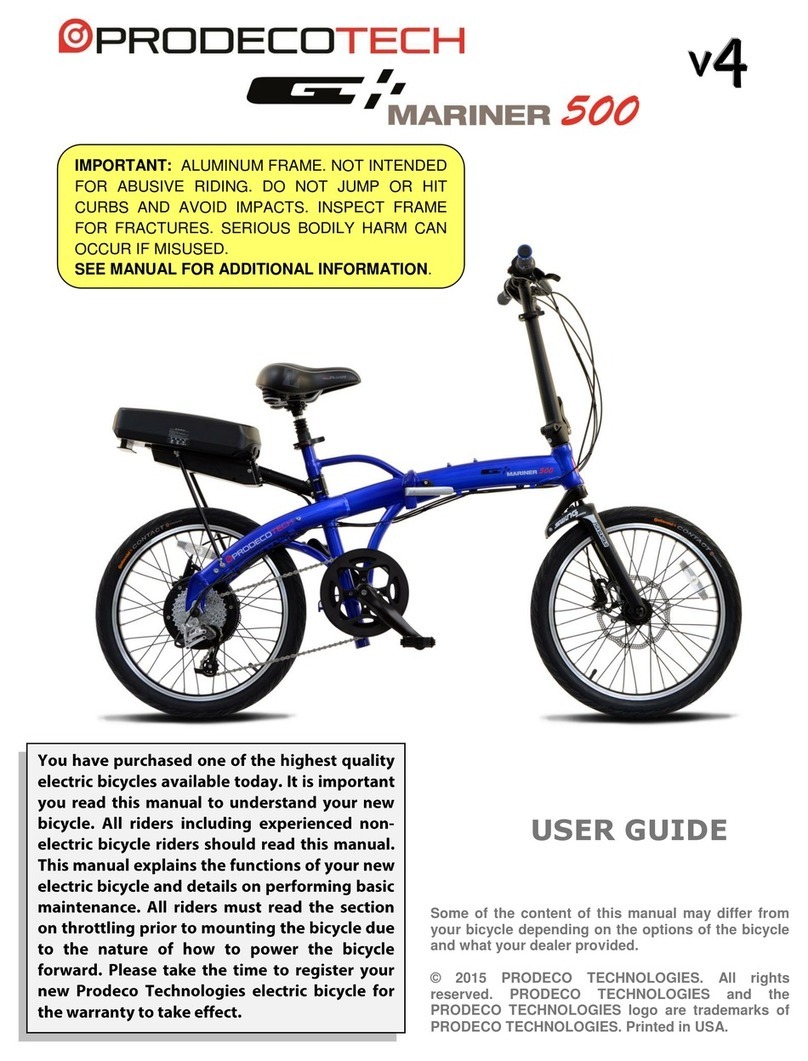
Prodeco Technologies
Prodeco Technologies Mariner 500 v4 User manual
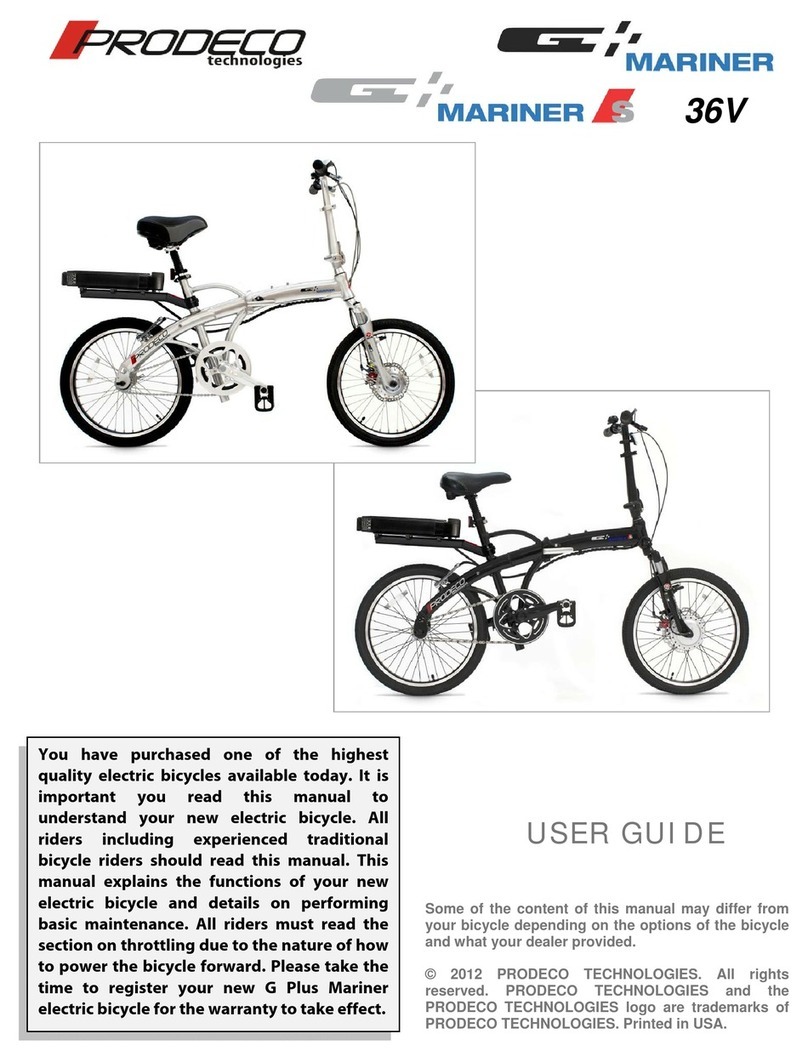
Prodeco Technologies
Prodeco Technologies G Plus Mariner 36V User manual
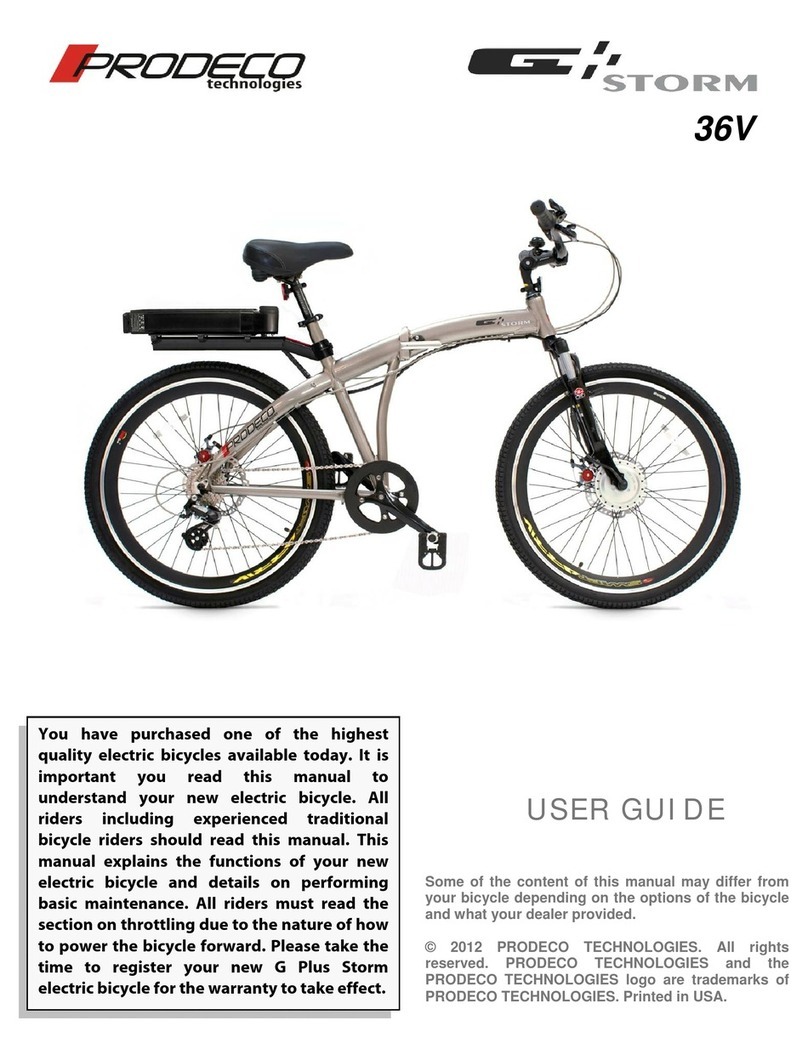
Prodeco Technologies
Prodeco Technologies G Plus Storm User manual
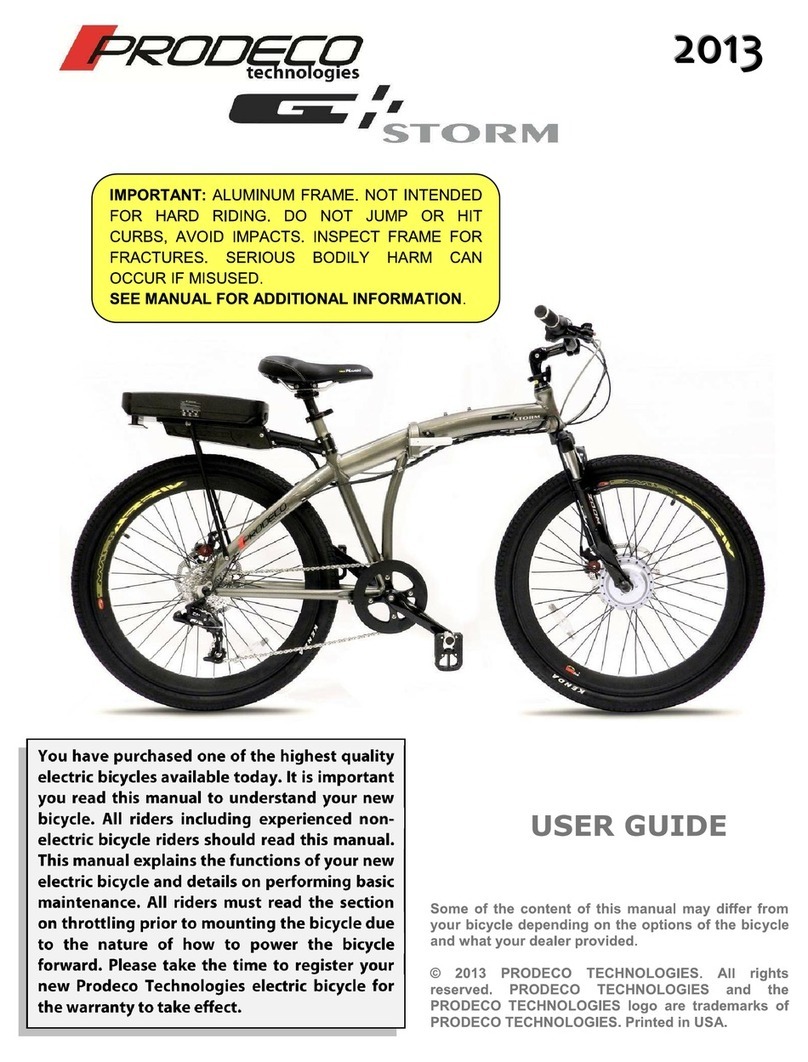
Prodeco Technologies
Prodeco Technologies Storm 2013 User manual
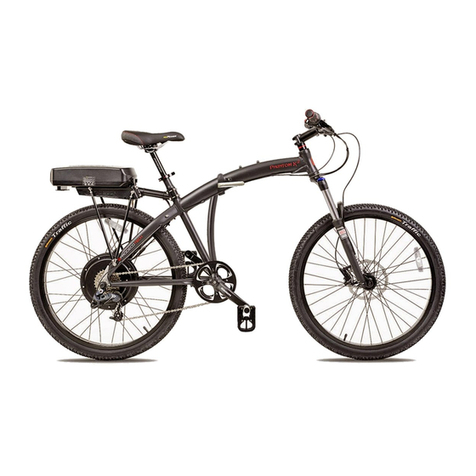
Prodeco Technologies
Prodeco Technologies Phantom X2 2013 User manual

Prodeco Technologies
Prodeco Technologies G Storm User manual

Prodeco Technologies
Prodeco Technologies Outlaw SS 2013 User manual
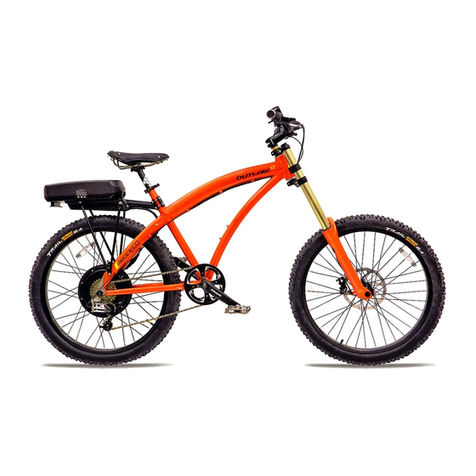
Prodeco Technologies
Prodeco Technologies Outlaw SE User manual
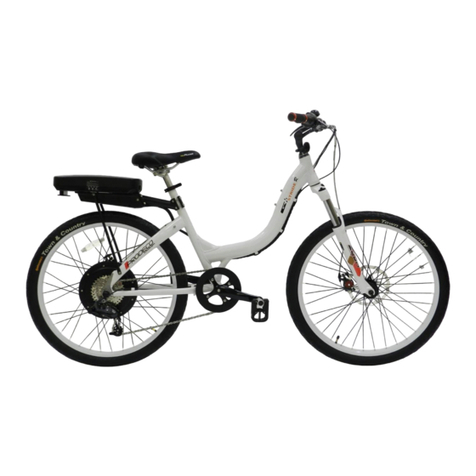
Prodeco Technologies
Prodeco Technologies Stride 500 User manual

Prodeco Technologies
Prodeco Technologies Mariner User manual

